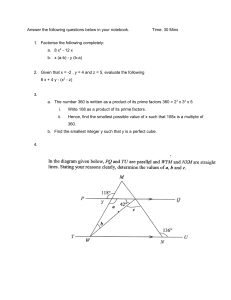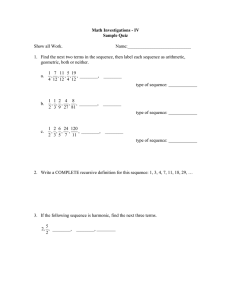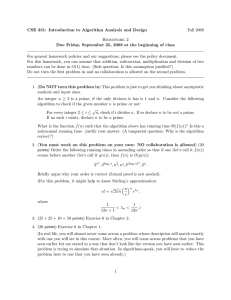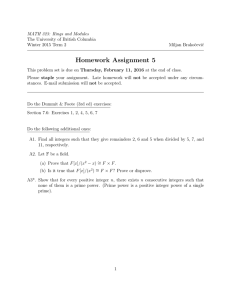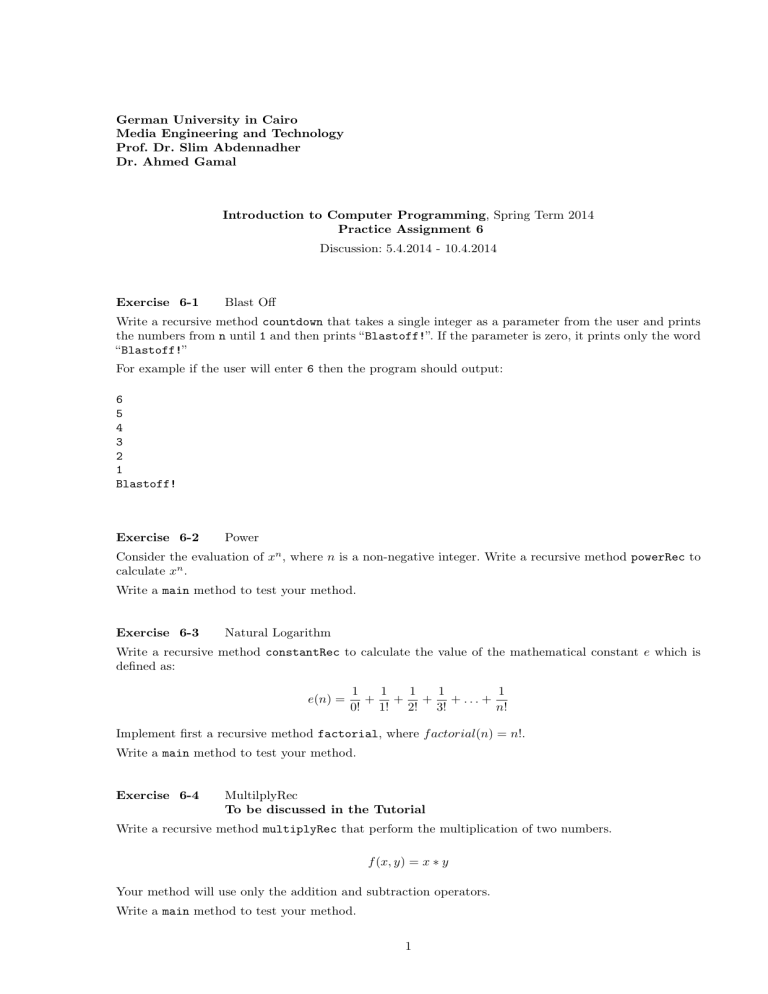
German University in Cairo
Media Engineering and Technology
Prof. Dr. Slim Abdennadher
Dr. Ahmed Gamal
Introduction to Computer Programming, Spring Term 2014
Practice Assignment 6
Discussion: 5.4.2014 - 10.4.2014
Exercise 6-1
Blast Off
Write a recursive method countdown that takes a single integer as a parameter from the user and prints
the numbers from n until 1 and then prints “Blastoff!”. If the parameter is zero, it prints only the word
“Blastoff!”
For example if the user will enter 6 then the program should output:
6
5
4
3
2
1
Blastoff!
Exercise 6-2
Power
Consider the evaluation of xn , where n is a non-negative integer. Write a recursive method powerRec to
calculate xn .
Write a main method to test your method.
Exercise 6-3
Natural Logarithm
Write a recursive method constantRec to calculate the value of the mathematical constant e which is
defined as:
e(n) =
1
1
1
1
1
+ + + + ... +
0! 1! 2! 3!
n!
Implement first a recursive method factorial, where f actorial(n) = n!.
Write a main method to test your method.
Exercise 6-4
MultilplyRec
To be discussed in the Tutorial
Write a recursive method multiplyRec that perform the multiplication of two numbers.
f (x, y) = x ∗ y
Your method will use only the addition and subtraction operators.
Write a main method to test your method.
1
Hint:
x ∗ y = x + x + ... + x
|
{z
}
y times
Exercise 6-5
Division
Write a recursive Java method divideRec that perform the integer division operation of two numbers. If
y is a negative number, an error message has to be displayed.
f (x, y) =
x
y
DO NOT USE THE JAVA PREDEFINED OPERATOR /.
Hint:
x
=
y
0
1+
: if x < y
: Otherwise
x−y
y
Write a main method to test your method.
Exercise 6-6
Modulus
Write a recursive Java method ModulusRec that perform the modulus operation of two integers. If y is a
negative number, an error message has to be displayed.
f (x, y) = x%y
DO NOT USE THE JAVA PREDEFINED OPERATOR %.
Hint:
0
x
x%y =
(x − y)%y
: if x = 0
: if x < y
: Otherwise
Write a main method to test your method.
Exercise 6-7
Sum of Digits
Write a recursive method to determine the sum of the digits of an integer. For example, the sum of digits
of 51624 is 5 + 1 + 6 + 2 + 4 = 18.
Exercise 6-8
Number of Digits
Write a recursive Java method numberDigitsRec, which given an integer, returns its number of digits.
For example the call numberDigitsRec(12312) will return 5.
Exercise 6-9
Prime
A prime number is an integer that cannot be divided by any integer other than one and itself. For example,
7 is prime because its only divisors are 1 and 7. The integer 8 is not prime because its divisors are 1, 2,
4, and 8.
Another way to define prime is:
2
prime(N)
= prime(N, N-1)
prime(N, 1) = true
prime(N, D) = false
prime(N, D-1)
if D divides N
otherwise
For example,
prime(4)
= prime(4,3)
prime(4,3) = prime(4,2)
prime(4,2) = false
Another example,
prime(7)
prime(7,6)
prime(7,5)
prime(7,4)
prime(7,3)
prime(7,1)
=
=
=
=
=
=
prime(7,6)
prime(7,5)
prime(7,4)
prime(7,3)
prime(7,2)
true
Translate the math-like definition of prime into two Java methods that return boolean. Use the % operator
to test divisibility. Put your method into a class, write a testing class, and test your program. (Look at
Triangle.java in this assignment.)
Exercise 6-10
Cube numbers
Write a program that implements this definition of cube numbers, where N is an integer entered by the
user.
cube(1) = 1
cube(N) = cube(N-1) + 3(square(N)) - 3N + 1
Implement the square() method using this definition (also given in Lab assigment 7):
(N − 1)2 = N 2 − 2N + 1
Exercise 6-11
Binomial Coefficient
The binomial coefficient nk is the number of ways of picking k unordered outcomes from n possibilities,
also known as a combination or combinatorial number.
The binomial coefficient is defined recursively as follows:
1
n
1
=
n−1
k
+
k
:
:
n−1
:
k−1
if k = 0
if n = k
otherwise
Write a recursive method to calculate the binomial coefficient. Make sure that n is less than k.
Write a main method that will allow the user to enter the actual parameters of the binomial coefficient
method. Use either Scanner class or the command line arguments as input mechanism.
public s t a t i c void main ( S t r i n g [ ] a r g s ) {
Scanner s c = new Scanner ( System . i n ) ;
....
3
Exercise 6-12
CountRec
Write a recursive method named countRec that accepts two arguments: a String value, and a char
value. Your method is to return the total number of times the character appears inside of the string.
Exercise 6-13
Reverse
Consider reversing the characters in a string. Write a recursive Java method reverseRec that returns a
new string with the same characters of the original string, but in reversed order.
Think about the base case and recursive case:
• Base case: ReverseRec("") => ""
• Recursive case:
reverse("ABCDE") => "E" + ReverseRec("ABCD") => ......
=> "EDCBA"
Hint: In addition to the methods charAt and length, use the predefined method substring(). For
example if we have a string String s = "CSEN202", then s.substring(1) returns "SEN202", i.e. the
string s without the first character.
Write a main method to test your method.
Exercise 6-14
Palindrome
To be discussed in the Tutorial
Write a recursive method palindrome that takes a single string as a parameter from the user and returns
a string representing the palindrome of it.
Exercise 6-15
CountRec2
Write a recursive method named countRec that accepts two arguments: a String value, and a char
value. Your method is to return the total number of times the second argument (the single character
value) appears inside of the first argument. For example:
public c l a s s Count {
// your co u nt method g o e s h e r e !
public s t a t i c void main ( S t r i n g a r g s [ ] ) {
System . out . p r i n t l n ( count ( " H e l l o " ,
System . out . p r i n t l n ( count ( " H e l l o " ,
System . out . p r i n t l n ( count ( " H e l l o " ,
System . out . p r i n t l n ( count ( " H e l l o " ,
}
’l ’)
’o ’ )
’H ’ )
’h ’ )
);
);
);
);
//
//
//
//
displays
displays
displays
displays
2
1
1
0
}
Exercise 6-16
Replace
Write a recursive method replace that takes two arguments: String and char and replaces each occurrence of the character with a ’*’
Exercise 6-17
Eliminate
Write a recursive method eliminate that takes a String and a char and deletes each occurrence of this
character from the string.
4
Exercise 6-18
Recursion Tracing 1
To be discussed in the tutorials
Give the following program:
public s t a t i c void mystery1 ( int a , int b ) {
i f ( a <= b ) {
int m =(a + b ) / 2 ;
SYstem . out . p r i n t (m + " ␣ " ) ;
mystery1 ( a , m − 1 ) ;
mystery1 (m+1, b ) ;
}
}
What is the output of the main method below? Justify your answer with a tracing table.
public s t a t i c void main ( S t r i n g [ ] a r g s ) {
int n = 6 ;
mystery1 ( 0 , n ) ;
}
Exercise 6-19
Recursion Tracing 2
Give the following program:
public s t a t i c void mystery ( S t r i n g p r e f i x , S t r i n g remaining , int k ) {
i f ( k == 0 ) {
System . out . p r i n t l n ( p r e f i x ) ;
return ;
}
i f ( r e m a i n i n g . l e n g t h ( ) == 0 ) return ;
mystery ( p r e f i x + r e m a i n i n g . charAt ( 0 ) , r e m a i n i n g . s u b s t r i n g ( 1 ) , k −1);
mystery ( p r e f i x , r e m a i n i n g . s u b s t r i n g ( 1 ) , k ) ;
}
a) What is the value returned by the following invocation? Trace your program. mystery("", "CSEN", 3)
b) What does the above method do? Give an concise verbal description of how the value returned by
mystery("", s, k) is related to the values of the parameters s and k.
Exercise 6-20
Search
Write a recursive method search() to search for a char inside a String and returns its position inside
the String. The method should returns -1 if the char is not in the String.
Use the following main method to test your program:
public s t a t i c void main ( S t r i n g [ ] a r g s ) {
System . out . p r i n t l n ( s e a r c h ( " example " , ’ a ’ ) ) ;
}
Hint:
• “Hello”.substring(1) returns “ello”.
• “Hello”.substring(1,4) returns “ell”.
• “Hello”.substring(0,s.length()-1) returns “Hell”.
5


